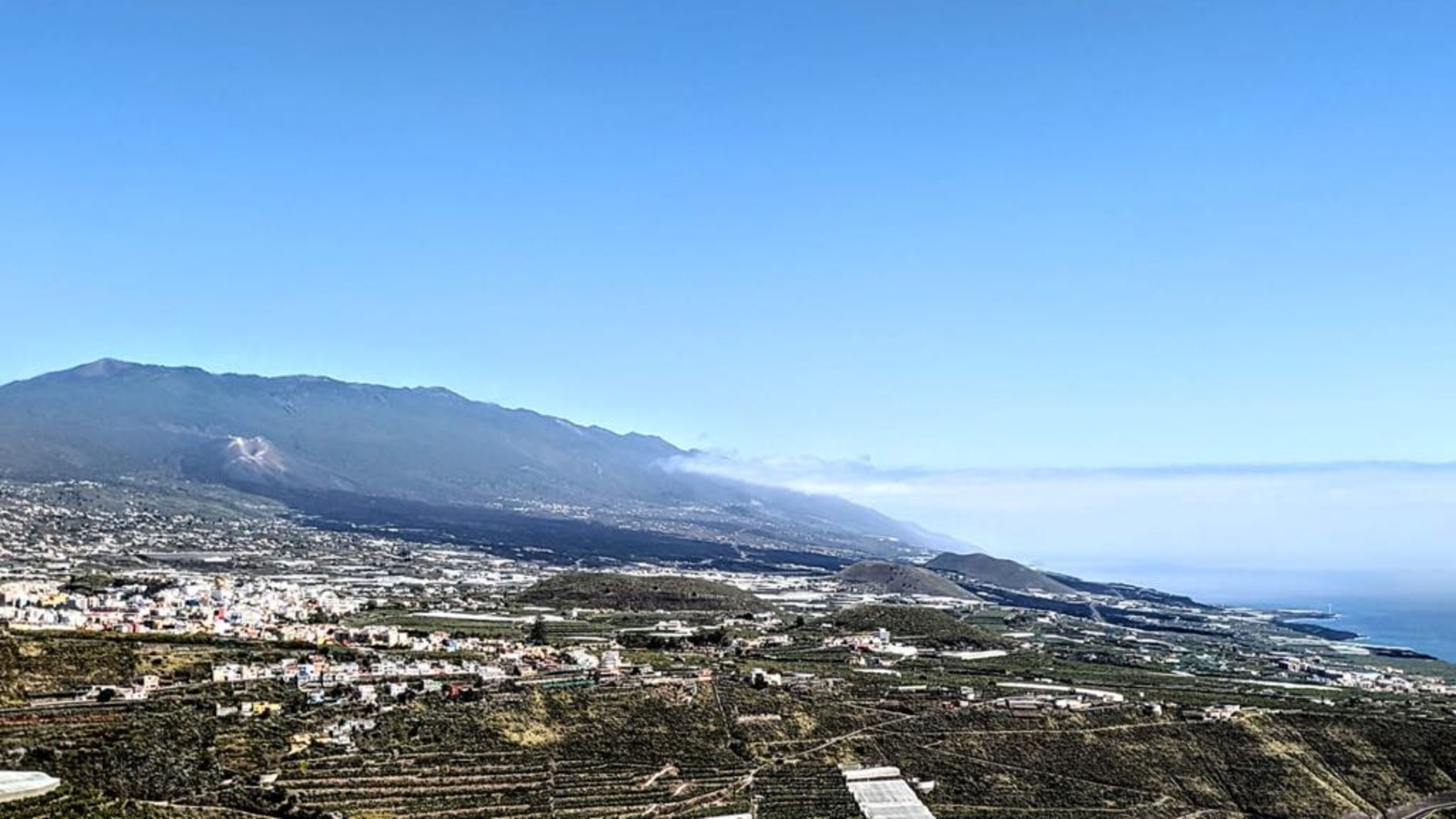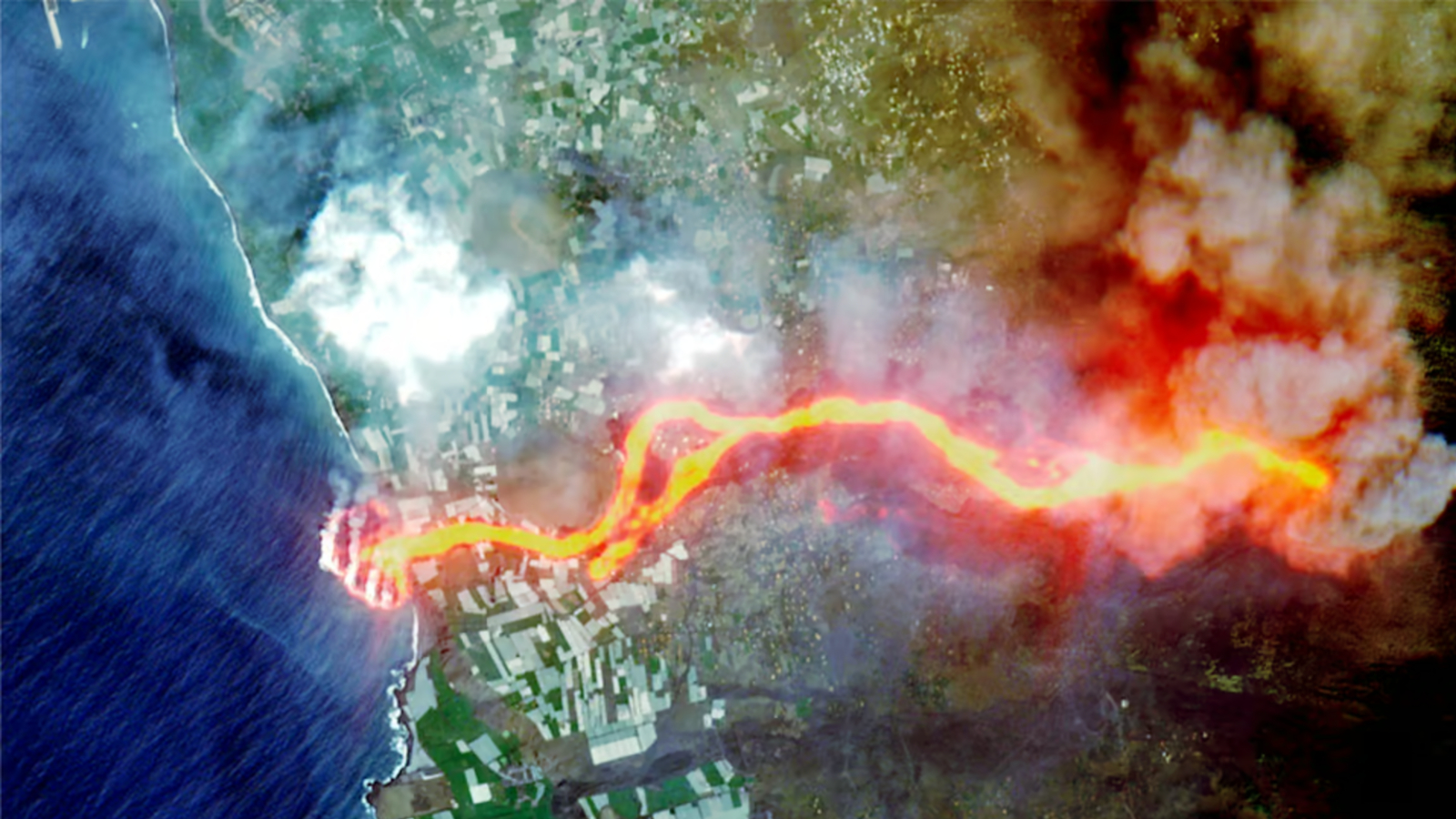QUICK FACTS
Where is it? La Palma, Canary Islands [28.62120467, -17.89960469]
What’s in the photo? A highly destructive lava flow winding into the sea
Which satellite took the photo? European Space Agency’s Sentinel-2 mission
When was it taken? Oct. 1, 2021
This striking satellite photo shows red-hot lava winding into the sea during a volcanic eruption on La Palma in the Canary Islands. The “river of fire” completely wiped out a small town and unleashed plumes of toxic gases, which have plagued the Spanish island for years, locals and experts told Live Science.
On Sept. 19, 2021, after a swarm of more than 22,000 earthquakes in less than a week, a large fissure suddenly opened up above the town of Todoque on the western flank of Cumbre Vieja — a volcanic ridge that runs through the southern half of La Palma — shooting lava fountains hundreds of feet in the air. The effusive eruption, which was the first volcanic outburst on the island since 1971, persisted for 85 days until Dec. 13, according to the Global Volcanism Program at the Smithsonian National Museum of Natural History.
During this time, around 7.1 billion cubic feet (200 million cubic meters) of molten rock poured out from a 660-feet-tall (200 meters) cone-shaped vent, named Tajogaite, which grew around the fissure. The fiery rock, which reached temperatures of up to 2,000 degrees Fahrenheit (1,100 degrees Celsius), flowed down toward the coast and into the Atlantic Ocean, creating around 4.6 million square feet (430,000 square meters) of new land in the process.
The lava flows, which stretched up to 4 miles (6.4 kilometers) long, were clearly visible from space and ended up covering a total area of around over 2,500 acres (1,000 hectares), including Todoque, which was essentially wiped off the map. Around 3,000 buildings were damaged or destroyed, along with large swathes of surrounding banana farms. The estimated damage exceeded 700 million euros (US$ 780 million), according to Spanish newspaper El Pais.
One person was killed by the eruption: an elderly man who is believed to have died from inhaling toxic volcanic gases while ignoring official advice and prematurely returning to his home in the exclusion zone, according to AFP. Thousands of wild and agricultural animals are also believed to have been killed by the lava flow and resulting gases.
Related: See all the best images of Earth from space
The damage was “truly terrible,” Marie Edmonds, a volcanologist at the University of Cambridge, told Live Science at the recent STARMUS Festival, an annual science festival that was held in the neighboring town of Puerto Naos from April 25 to April 29. “Most shocking to me is the closeness of the vent to the communities,” she added when describing what it was like to visit the area during the festival. “It must have been absolutely terrifying to see the eruption so close.”
Local resident David, who used to live in Todoque and now resides in the neighboring town of Los Llanos de Aridane, was one of 7,000 people evacuated from their homes during the eruption. The shopkeeper told Live Science that he watched the lava flows burn across the landscape like a “river of fire,” as his house was destroyed by the molten rock.
Toxic lava flows
The eruption was particularly noteworthy due to high levels of volcanic gases that were released into the air. This was the result of unusually high levels of sodium and potassium in the lava, which made it highly alkaline and increased the amount of gases, such as sulfur dioxide, that were emitted, Edmonds told Live Science.
Where lava reached the coastline — and dripped into the ocean via giant lava falls — other gases, such as hydrogen chloride, were also released, she added.
Throughout the eruption, an exclusion zone was put in place around lava flows to protect people from the gases. However, some locals ignored official advice and snuck back into the area to visit their properties.

Taxi driver Ramón was one of those who went home after the eruption had ceased, but before people were given the green light to return. After just a few minutes, he began to get lightheaded and started struggling to breathe before passing out. He later awoke in the hospital and spent several days being treated for toxic gas inhalation.
“I thought that I was going to die,” Ramón told Live Science as he drove past Tajogaite. More than three years later, he still struggles with shortness of breath.
While the worst volcanic gases have now dissipated, the problem is not totally gone. Large pockets of carbon dioxide still lie in lava tubes and other natural depressions in the area and could be harmful to people if they unknowingly walk through them, Edmonds said. “It is unknown how long this hazard will persist,” she added.
Locals also claim that they can still smell the eggy fumes of sulfur dioxide whenever it rains.
Widespread disruption
The initial explosive phase of the eruption triggered large plumes of ash and smoke into the atmosphere that could be clearly seen from Tenerife, around 90 miles (145 km) away, and caused several brief airport closures throughout the Canary Islands.
The plumes also caused a temporary disruption to the astronomical work being done by researchers at the various telescopes located at Las Palmas’ Roque de los Muchachos Observatory (ORM), which is situated at an altitude of around 7,900 feet (2,400 m).
“The disruption only lasted for around a week,” Alba Fernandez-Barral, an astronomer and chief communications officer at the Cherenkov Telescope Array Observatory at ORM, told Live Science. “But for several telescopes, this was the first time they had stopped collecting data for decades.”
The atmospheric disturbances soon dissipated, but the continuing lava flows put a halt to most day-to-day activities in the area surrounding Tajogaite. Locals became so concerned that one Canarian politician even suggested detonating bombs within the erupting cone to stem the flow of lava, although this idea was never seriously considered.
However, for locals, the issues persisted long after the lava eventually ceased flowing.
The biggest problem was that the only road between Los Llanos de Aridane and Puerto Naos was destroyed, meaning that the only way to get from one to the other was to drive all the way around Cumbre Vieja, which means driving half of the island’s coastline. Ramon told Live Science that the journey that once took 10 minutes could now take up to an hour and a half.
Construction on a new road began almost as soon as the eruption ceased, while some of the lava was still at several hundred degrees F. The road was fully constructed within two years and can be seen from space winding through the lava flats, according to NASA’s Earth Observatory.
Although the area is now fully accessible, tourists and some islanders have continued to avoid the area due to fears over the toxic gases. One local official at STARMUS, who did not want to be named, told Live Science that attending the festival marked the first time they have been back to the area since the eruption.
Back to normality
The eruption of Tajogaite has left long-lasting scars — both on the landscape and within the local community. But there are signs that these wounds are beginning to heal.
“The loss of entire neighbourhoods affected the society here very badly,” Edmonds told Live Science. “But I think that the people have bounced back incredibly well. Resilience is clearly very strong here.”
For many locals, the recent STARMUS Festival marked something of a return to normality as tourists flocked to La Palma in significant numbers for the first time since early 2021.
Eruptions like this only happen on La Palma once every 50 years, Edmonds added, so it should be a while before anything like this happens again.
